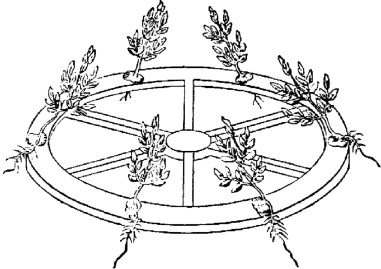Classes have begun, and this semester (and every spring semester) I have the opportunity to teach our introduction to horticulture class, otherwise known as Plant Propagation (Hort 1001). We usually have about 120 students, and I don’t want to brag or anything, but it is just about the best class out there. Watching the students learn about seeds, cuttings, and grafting in the labs is one of the most motivating things about my job (and it doesn’t hurt that the greenhouses are about 70 degrees while it’s 0 outside). But, as you might expect, there is a lecture too. Believe it or not, the lecture isn’t half bad. In fact, students actually ask questions in class. This past Tuesday during a lecture on seeds one of the students asked how the roots know how to grow down when they exit the seed. The answer is geotropism. Geotropism is a response by a plant to gravity. Some parts of a plant grow towards a gravitational pull (roots), and some grow away from it (shoots). One of the coolest experiments ever was a study done by a gentleman named Thomas Knight in the very early 1800s where he set up a water wheel which had seeds planted along the edges. As the wheel spun and the plants grew they responded both to the Earth’s gravity and to the force created by the spinning wheel. You can see the results below.

Knight also did some very interesting work showing that buds from older plants retained their physiological age when grafted onto younger plants. Basically that means that if you graft a bud from a mature ‘Honeycrisp’ apple onto a young seedling, that bud will produce a new shoot which produces ‘Honeycrisp’ apples before the rest of the tree produces apples.
Usually when we think of horticulture we think of L. H. Bailey – and we should – but let’s never forget Thomas Knight either.
That’s great. I wrote a post last year dealing with Gravitropism which basically dealt with the same phenomena. I love almost every anomaly with regards plant growth. Most commonly when I hiked through the steep rugged mountainsides of the San Jacinto Mountains, you’d see trees which started out sideways as soil and other debris pushed them downward, but only to readjust themselves towards upright growth. Isn’t ornamental hort kool ? I wish the whole rest of the planet would think the same.